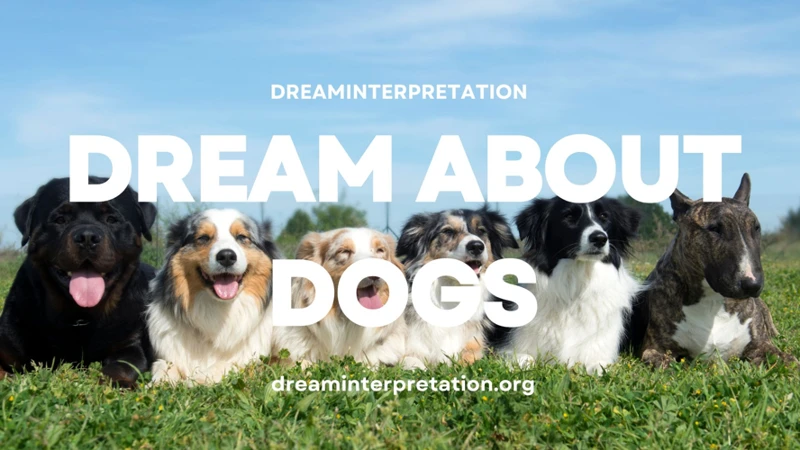Have you ever wondered what goes on inside your dog’s mind when they dream? It’s a question that has puzzled pet owners for ages. While we may never be able to directly peek into a dog’s dreams, scientists have made significant strides in unraveling the mysteries of canine dreams. In this article, we will explore the science behind these dreams, delve into common dog dream behaviors, and even discuss whether dogs have spiritual dreams. So, buckle up and get ready to embark on an intriguing journey into the world of canine dreams. Hold on to your leash because it’s going to be a fascinating ride!
The Science Behind Canine Dreams

Diving into the realm of canine dreams, scientists have conducted extensive research to uncover the secrets behind this intriguing phenomenon. Through advanced brain imaging techniques, such as electroencephalography (EEG), researchers have discovered that dogs, like humans, go through different stages of sleep, including REM (rapid eye movement) sleep. During REM sleep, dogs experience increased brain activity and vivid dreams. This is evidenced by observed twitching, leg movements, and even occasional barking or growling. According to a study conducted by Matthew Wilson at MIT, dogs exhibit similar patterns of neural activity while dreaming as they do when awake and actively engaged in an activity. This suggests that dogs may be reimagining past experiences and processing information through their dreams. The discovery of the hippocampus, the region responsible for memory consolidation, in dog brains supports the theory that dogs use dreams to remember and solidify their experiences. So, it seems that our furry companions have their very own dream world, where they can relive adventures, revisit familiar faces, and perhaps even confront imaginary creatures. The scientific exploration of canine dreams continues to fascinate researchers, providing glimpses into the intricacies of a dog’s complex inner world.
Understanding the Basics of Dog Dreams

To understand the basics of dog dreams, it’s helpful to explore the similarities between human and canine dreams as well as the unique aspects of dog dreams. Like humans, dogs experience REM sleep, which is when dreaming primarily occurs. During this stage, their brain activity increases, and they may exhibit physical movements and vocalizations. Dogs also have similar sleep cycles to humans, including light sleep, deep sleep, and REM sleep. However, there are some distinct differences in how dogs dream. Unlike humans, who often dream in a narrative form, dog dreams seem to be more sensory and based on their daily experiences. They may dream about smells, sounds, and even specific activities from their everyday life. Dogs may also engage in behaviors during dreams that reflect their instinctual tendencies, such as running, chasing, or whimpering. Understanding these basic elements of dog dreams can help us appreciate the fascinating world that exists within our canine companions’ minds.
1. Similarities Between Human and Canine Dreams
Similarities exist between human and canine dreams, shedding light on the shared aspects of our subconscious experiences. One parallel is the occurrence of REM sleep, during which both humans and dogs experience heightened brain activity and vivid dreaming. Just like humans, dogs exhibit physical manifestations of their dreams, such as twitching and leg movements. Additionally, studies have shown that dogs’ neural activity during dreams mirrors their awake state, indicating that they may be engaging in mental reenactments of past events. This similarity suggests that both humans and dogs use dreams as a way to process and consolidate memories. While we may never fully comprehend the content of our furry friends’ dreams, recognizing these parallels provides a deeper appreciation for the universality of the dreaming experience.
2. Unique Aspects of Dog Dreams
When it comes to dog dreams, there are certain unique aspects that set them apart from human dreams. One intriguing aspect is the ability of dogs to incorporate their heightened sense of smell into their dream experiences. Dogs rely heavily on their sense of smell in daily life, so it’s no surprise that it plays a significant role even in their dreams. Just as humans might dream about familiar scents, dogs may also encounter smells from their past experiences while they dream. Another interesting feature of dog dreams is their tendency to exhibit physical movements and vocalizations during REM sleep. This can manifest in various ways, such as tail wagging, running, whimpering, or even occasional barking. These physical behaviors suggest that dogs are not just passive observers in their dreams but actively participating in the scenarios they imagine. While we may not fully understand all the intricacies of dog dreams, these unique aspects provide a glimpse into the rich and fascinating dream world of our canine companions.
Interpreting Common Dog Dream Behaviors

When it comes to interpreting common dog dream behaviors, it’s important to pay attention to their body language and vocalizations. Dogs often exhibit tail wagging and running in their dreams, which can indicate excitement or joy. Whimpering and growling, on the other hand, may suggest that they are experiencing fear, anxiety, or even reliving a past stressful event. Chasing and retreating behaviors in dreams could signify their instinctual hunting or protective instincts. It’s essential to consider the context of these behaviors and observe any patterns that emerge. Whether your pup is chasing imaginary squirrels or reenacting a playful encounter, understanding their dream behaviors can give us valuable insights into their inner thoughts and emotions. So, next time you see your four-legged friend twitching or vocalizing during sleep, take a moment to contemplate the exciting world they are exploring in their dreams.
1. Tail Wagging and Running
1. Tail Wagging and Running
One common behavior that dogs may exhibit in their dreams is tail wagging and running. As you observe your furry friend snoozing peacefully, you might notice their tail twitching and wagging as if they are chasing something or excitedly greeting someone. This dream behavior often indicates that your dog is reliving an enjoyable experience or engaging in a playful encounter within their dream world. It’s fascinating to witness their tails wagging and their paws twitching as they sprint in their sleep. It’s a reminder of their active and joyful nature, even in the realm of dreams. So, the next time you see your pup’s tail wagging fervently in their slumber, you can rest assured that they are enjoying their own delightful dream adventure. To learn more about the various interpretations of dog dreams, you can check out our article on “What Does a Dream About Bears Mean?” for further insights into the symbolism behind canine dreams.
2. Whimpering and Growling
Whimpering and growling are common dream behaviors exhibited by dogs during REM sleep. These vocalizations may come as a surprise to pet owners who witness their dog’s seemingly intense reactions while asleep. Theories suggest that whimpering and growling in dreams could be a response to imagined threats or conflicts. Dogs may be experiencing a dream scenario where they feel the need to defend themselves or communicate their discomfort. It’s important to note that these dream behaviors do not necessarily reflect the dog’s true emotions while awake. To better understand the meaning behind these vocalizations, it’s essential to observe your dog’s body language and overall behavior when they wake up from such dreams. In some cases, it could be a sign of anxiety or fear that warrants further attention and care. So, next time you hear your furry friend whimpering or growling in their sleep, remember that they may just be engaged in a vivid dream, navigating their own surreal world of adventures and emotions.
3. Chasing and Retreating
One common behavior observed in dog dreams is the act of chasing and retreating. During their REM sleep, dogs may engage in imaginary pursuits, often characterized by running, pawing the air, and even barking. This behavior can be reminiscent of their instinctual drive to chase prey or play with their canine companions. It’s fascinating to watch our sleeping pups as they seem to navigate an imaginary world, darting after elusive targets or quickly retreating from perceived threats. While we can’t be certain of the exact content of their dreams, this behavior suggests that dogs may be reliving their favorite games or exercising their natural instincts. It’s a sight that reminds us of the playful spirit and boundless energy our dogs possess, even in their dreams.
Diving into the Canine Dream World

Diving into the intriguing world of canine dreams, we discover that dogs have their own vivid and immersive dream experiences which allow them to explore their senses, memories, and daily activities. During their dreams, dogs may embark on sensory adventures where they can once again savor the smells and sounds of their favorite places. They may also find themselves revisiting familiar faces, both human and canine, as they journey into the realm of past interactions and cherished memories. Additionally, dogs often relive their daily activities in their dreams, engaging in playful chases, re-enacting walks, and even mimicking mealtime rituals. It’s as if their dreams provide them with a virtual reality experience where they can relish in the joys of their everyday lives. While we can only speculate on the exact content and meaning of their dreams, it’s clear that dogs have a rich and immersive dream world of their own, filled with sights, smells, sounds, and boundless adventure. So, next time you see your furry friend peacefully napping, take a moment to ponder the fascinating journeys they may be embarking on in their dreamland.
1. Exploring Their Senses: Smells and Sounds
In the mysterious world of dog dreams, our furry friends embark on sensory adventures, exploring smells and sounds in ways that may surprise us. During sleep, dogs have heightened olfactory capabilities, and their dreams often revolve around familiar scents. They may catch whiffs of their favorite treats, beloved playmates, or the enticing aroma of nature’s wonders. Research suggests that the auditory experience is also a significant part of a dog’s dream. Dogs may dream about familiar sounds, such as their owner’s voice, the sound of their leash being taken out for a walk, or the joyful barking of their canine companions at the park. These dream experiences provide a fascinating glimpse into the sensory world that exists within the realm of a dog’s subconscious mind. So, the next time you see your pup twitching or wagging their tail in their sleep, it’s possible they’re exploring a vivid mental landscape filled with familiar smells and sounds. Truly, the canine dream world is a wonder to behold.
2. Revisiting Familiar Places and Faces
During their dreams, dogs have the intriguing ability to revisit familiar places and faces. Just like humans who often dream about familiar settings, dogs can also transport themselves to locations they have encountered in their waking lives. It’s not uncommon for a dog to dream about their favorite park where they love to run and play fetch, or to envision the friendly face of their beloved human companion. Their dreams serve as a way to revisit these cherished experiences and relive the joyous moments spent in familiar environments. It’s truly remarkable how dogs can bring their memories to life in their dreams, immersing themselves in the sights, sounds, and scents of their most beloved places. This ability to revisit familiar places and faces further emphasizes the intricate workings of a dog’s dream world and their deep emotional connections with the world around them.
3. Reliving Daily Activities
In the realm of canine dreams, one fascinating aspect is their ability to relive their daily activities. Dogs spend a significant portion of their waking hours engaging in various routines and behaviors, and these experiences may manifest in their dreams. Just as humans may dream about familiar activities or tasks, dogs, too, can mentally rehearse their daily endeavors. For example, a dog may dream about going for a walk in the park, playing fetch with their favorite toy, or receiving belly rubs from their beloved human companion. These dreams serve as a way for dogs to reinforce their memories and emotions associated with these experiences. So, it’s not uncommon to see a dog’s paws twitch or hear soft barks as they mentally recreate their everyday adventures. It’s a window into their consciousness and a testament to the rich inner lives of our canine friends.
The Spiritual Connection: Do Dogs Have Spiritual Dreams?

The question of whether dogs have spiritual dreams is a subject that sparks curiosity and wonder. While it is difficult to definitively understand the nature of a dog’s dreams, some pet owners and experts believe that dogs may indeed have spiritual experiences while they sleep. Dogs are known for their deep emotional connection with their human counterparts, and many people believe that this connection extends beyond the physical realm. Some pet owners have reported witnessing their dogs exhibiting behaviors during sleep that suggest a spiritual encounter, such as appearing to interact with invisible entities or displaying signs of peace and contentment. However, scientific research specific to the spiritual aspects of dog dreams is limited, and it remains a topic of subjective interpretation. Whether dogs have spiritual dreams or not, the bond they share with their humans is undeniably special and continues to be a source of joy and companionship.
Can We Influence or Control Their Dreams?

While we may not have direct control over our dogs’ dreams, there are some ways in which we can indirectly influence their dream content. Providing a stimulating and enriching environment during the day can lead to more vibrant dreams at night. Taking our dogs on engaging walks, introducing them to new scents, and providing mentally stimulating toys and puzzles can all contribute to a more fulfilling waking experience which may carry over into their dreams. Additionally, ensuring our dogs have a comfortable and safe sleeping environment can enhance the quality of their sleep and potentially their dreaming. While we can’t dictate the specific content of their dreams or manipulate their dream scenarios, we can play an active role in creating positive waking experiences that may positively impact their dream world. So, let’s make sure our furry friends have plenty of exciting adventures during the day, and who knows what kind of incredible dreams they’ll embark on during their slumber.
Why Do Dogs Bark in Their Dreams?

Why do dogs bark in their dreams? It’s a question that has intrigued dog owners for years. When dogs bark in their dreams, it’s often a reflection of their heightened state of mind during REM sleep. During this stage, dogs may be actively reliving a vivid dream, which could involve chasing prey, defending their territory, or playfully interacting with other dogs. Dogs’ vocal cords are still active during REM sleep, allowing them to bark, growl, or whimper as if they were awake. This is a natural expression of their dream experiences and should not be a cause for concern. While the exact content of their dreams remains a mystery to us, it is clear that dogs’ dreams can evoke a range of emotions and behaviors, including barking. So, the next time you hear your dog barking in their sleep, remember that they are simply immersed in their own dream world, chasing rabbits or playing with their furry friends. It’s all part of the fascinating phenomenon of canine dreams.
Common Misconceptions About Dog Dreams
When it comes to dog dreams, there are several common misconceptions that deserve clarification. First and foremost, one misconception is that dogs only dream about chasing and playing. While these activities are certainly common dream themes for our canine friends, their dreams can be much more diverse and complex. Dogs may dream about a variety of experiences, such as reliving daily activities, exploring familiar places, or even encountering imaginary scenarios. Another misconception is that dogs only dream during REM sleep. While this stage is associated with vivid dreaming, dogs can also have dreams during non-REM sleep. Additionally, some may believe that dogs dream exclusively in visual images. However, their dreams can involve multisensory experiences, including sounds, smells, and even sensations. It’s important to remember that dogs, like humans, have a rich and diverse dream world that we are only just beginning to understand. So, next time you see your four-legged companion twitching or barking in their sleep, know that their dreams may be far more complex than we imagine.
Conclusion
In conclusion, while the mysteries of canine dreams may never be fully understood, scientific research has shed some light on this fascinating topic. Dogs, like humans, experience dreams during their sleep, and these dreams serve various functions, such as memory consolidation and emotional processing. Through their dreams, dogs may revisit familiar places and faces, relive daily activities, and perhaps even engage in fantastical adventures. While we may never know exactly what goes on in their minds during these dream episodes, it’s clear that dogs have an intricate dream world of their own. So the next time you see your furry friend wagging their tail or barking in their sleep, you can rest assured that they are on a unique journey through their own canine dreamland. To learn more about dreams and their meanings for humans, check out our article on “What Does It Mean to Dream About Ants Biting You?“.
Frequently Asked Questions
1. Can dogs dream about their owners?
Yes, dogs can dream about their owners. Dogs form strong emotional bonds with their owners, and these relationships often feature prominently in their dreams. They may dream about their owners playing with them, going for walks, or simply spending quality time together.
2. Do dogs have nightmares?
Yes, dogs can have nightmares just like humans. Nightmares are often associated with feelings of fear, anxiety, or stress. Dogs may display behaviors such as whimpering, growling, or even thrashing around during these dreams. Providing a secure and comforting environment can help reduce the occurrence of nightmares in dogs.
3. Are all dog dreams pleasant experiences?
Not all dog dreams are pleasant experiences. Just like humans, dogs can have both positive and negative dream experiences. While some dreams may make them wag their tails and romp around with joy, others might elicit fear, causing them to have a disturbed sleep.
4. Can dogs remember their dreams?
While it is difficult to determine the exact level of dream recall in dogs, some studies suggest that they can remember certain aspects of their dreams. Dogs may exhibit behaviors indicative of remembering a dream, such as returning to a place or object they encountered in their dream shortly after waking up.
5. Do all breeds of dogs dream equally?
Yes, all dog breeds possess the ability to dream. However, the content of their dreams and the frequency of certain behaviors during dreams may vary among different breeds. Some breeds known for their playful and active nature might have more vivid and energetic dream experiences.
6. Can dogs act out their dreams?
Yes, dogs can sometimes act out their dreams. It is not uncommon to observe a sleeping dog making running motions with their legs or barking in response to dream stimuli. Their physical movements during dreams are believed to be an involuntary response to their imagination.
7. Are there any health concerns associated with dog dreams?
Generally, dog dreams are considered a normal part of their sleep cycle and pose no health concerns. However, if a dog consistently exhibits intense or violent behaviors during dreams, such as thrashing or self-injury, consulting with a veterinarian may be advisable to rule out any underlying health conditions or sleep disorders.
8. Can I wake up my dog from a dream?
It is generally not recommended to wake a dog up from a dream unless it is absolutely necessary. Dogs, like humans, need uninterrupted sleep for their overall well-being. If you feel the need to intervene, try gently calling their name or softly touching them to help ease them out of their dream state.
9. Are there any signs that indicate a dog is dreaming?
Yes, there are several signs that indicate a dog is dreaming. These can include twitching paws, rapid eye movements under closed eyelids, occasional whimpering, growling, or barking sounds, and even changes in their breathing patterns. It’s important to remember that these indicators may vary from dog to dog.
10. Can dogs have recurring dreams?
Dogs, like humans, can have recurring dreams. Particularly memorable or emotionally charged experiences may be relived in their dreams multiple times. Recurring dreams could be about enjoyable activities, certain people or animals they have strong connections with, or even past traumas they may be processing.







